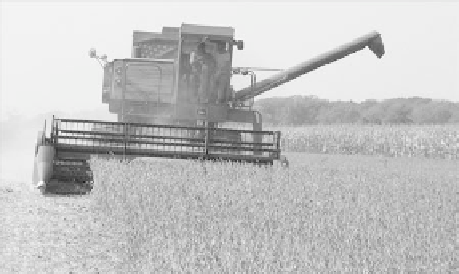Agriculture Reference
In-Depth Information
Some problem insects include aphids, spider mites, and leaf beetles. Normally,
these do not cause serious yield losses. Nematodes are microscopic worms that can
cause serious damage to soybeans. They infest the root system and can kill significant
portions of a field. The worms form cysts in the soil that can persist for several years.
The best control measure seems to be crop rotation and prevention of nematode spread
from infested fields.
3.5.9 Harvest and Storage
Harvesting of most soybean types is done by machine. The combine cuts the grain
stalks, separates the grain from leaves and dirt, and stores it in a small bin on the top
of the machine. A self-propelled combine is shown in Figure 3.34. The same
combine harvester used for maize and wheat can be used for soybeans with internal
adjustments and a change of a few screens. A grain moisture of 13.5 percent is con-
sidered ideal. Higher levels result in storage losses from fungi and costs for mechanical
drying. Lower moisture levels can result in splitting of the beans during harvesting and
losses caused by shattering of the pod before harvest.
Handling of soybeans in the field and transport to storage is similar to maize and
sorghum. The relatively high oil content of soybean grains makes it especially suscep-
tible to oxidation and fermentation. This makes low moisture content and avoidance of
heat important.
Edamame soybeans are eaten as a fresh vegetable and are harvested before the
grain matures and dries. The stage of harvest is critical. Harvesting too early results
in smaller grains and lower yields. Harvesting a few days too late gives hard grains
and a low sugar content. The entire plant is harvested and sold in bunches for home
use. For canned or frozen edamame, the beans are stripped from the pods.
3.5.10 Marketing
Soybeans are classed according to their biochemical characteristics, color, size, and
quality. Commercial channels recognize yellow soybean and mixed soybean, yellow
Figure
3.34.
Combine in soybeans.









